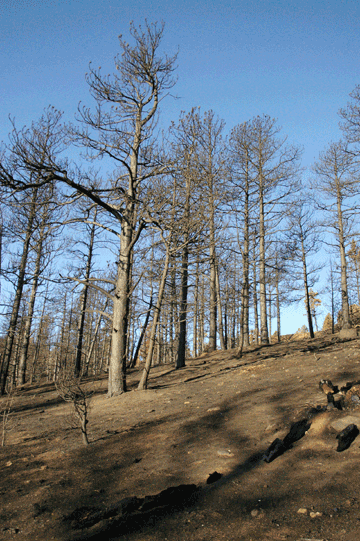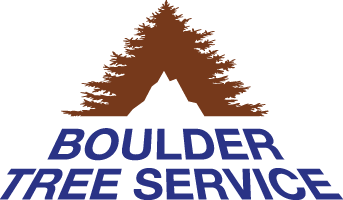Tree Work and
Fire Mitigation
 What to do with standing burned trees
What to do with standing burned treesThe fire in Sunshine and Four Mile Canyons left many property owners with burned and blackened trees. As a homeowner and a good steward of the land, you will need to determine the best approach to cutting, thinning or leaving these trees. It is important to consider the health of the trees and extent of fire damage before you start cutting. The best approach for managing your property for rehabilitation and restoring the land to a natural state varies drastically between green trees, damaged trees and areas where the fire burned hot, in some cases leaving no living organisms.
First determine the fire intensity that the ground received during the fire using the Department of Agriculture Natural Resources Conservation Service’s Fire Burn Intensity Classification information.
Fire Burn Intensity
Next, determine if your property has burned so hot that the land is sterile. In Medium to High Fire Intensity Areas, the chances are good the ground is sterile. What this means is that grasses and plants may not grow without mulch. You may want to consider hydro mulching in some areas. Seeding late in the fall is generally not effective, it’s best to wait until spring for planting. Mulching should start as soon as possible.
In areas that are Medium to High Fire Intensity Areas, your soil most likely will be hydrophobic, meaning the ground will actually repel water.
For more information on Hydrophobic Soils, see:
Soil Quality Resource Concerns: Hydrophobicity
Sterile Ground
Next, determine if your property has burned so hot that the land is sterile. In Medium to High Fire Intensity Areas, the chances are good the ground is sterile. What this means is that grasses and plants may not grow without mulch. You may want to consider hydro mulching in some areas. Seeding late in the fall is generally not effective, it’s best to wait until spring for planting. Mulching should start as soon as possible.
Mulch
Sterile, burned ground may need to be mulched. The State Forest Service has a list of Certified Weed Free Straw Sources. Weed free straw is very important to avoid planting noxious weeds in the burn area. You may give us a call for a copy of the list.
Erosion Control Using Burned Trees
With sterile ground and the likely hood of flash floods and debri flow, erosion control to save your property and the properties downhill of the burned area is very important. Please see our infomation on our technique to reduce erosion and debri flow post fire. We use the burned trees that need to be cut down to reduce erosion. The dead trees on site are the least expensive way to reduce erosion.
Deciding what to cut
Develop a plan that outlines how to use your dead trees to help with erosion control and help put nutrients back into the soil. Depending on your stand density, you may need to remove some trees, you can leave some trees for habitat and the rest should be used for erosion control. Branches may be chipped or lopped and scattered.
Contour Tree Felling
Any trees that have a chance of recovery from the fire should not be cut down at this time unless they pose a safety hazard. We can provide a certified arborist to determine which trees have a chance of survival; but when in doubt, wait and see if your trees will recover. Even an arborist may not be able to tell if a tree will survive.
What we can do for you and your property
We can help you come up with a plan for your burned property that addresses each of the considerations discussed above. Once a plan is developed, we can implement the plan to speed the recovery of your land.
There is limited funding for the removal of dead black trees. Please contact Bryan Baer with the Colorado State Forest Service for an application for the cutting of your trees at: 303-513-3888. We can also help you with this grant application.
If we are not able to help you with a plan or cutting of your burned trees, we can help you find a good contractor.
Conclusion
A good plan for is essential for your burned property. The Fourmile Emergency Stabilization Team is working on a mulching the drainage around the Four Mile Canyon drainage, they are not dealing with the black trees. Please contact me if you have any questions or if I can help you develop a plan for your property.
Eric Bader
Firefighter, sawyer, mitigation/rehab specialist
What happens if you do not cut down the dead trees and do erosion control?
Here is information for the Buffalo Creek Fire and Flood where the rain followed the fire before erosion controls could be put into place.
If you do not cut down your black, dead trees, eventually these trees will blow down, often pulling up their root ball. It may take 5-10 years for your trees to fall down. Until the trees fall down, our woods will not be safe to walk in. When they do fall, the trees will be “jack-strawed,” making a tangle of trees that may preclude sawyers from being able to cut the trees. Trees that cross each other and rest above the ground will dry out rather than rot, leaving them available to burn again for the next 10-25 years.
Boulder Tree Service
303-444-8420
Email: info@BoulderTreeService.com
303-444-8420
Email: info@BoulderTreeService.com
